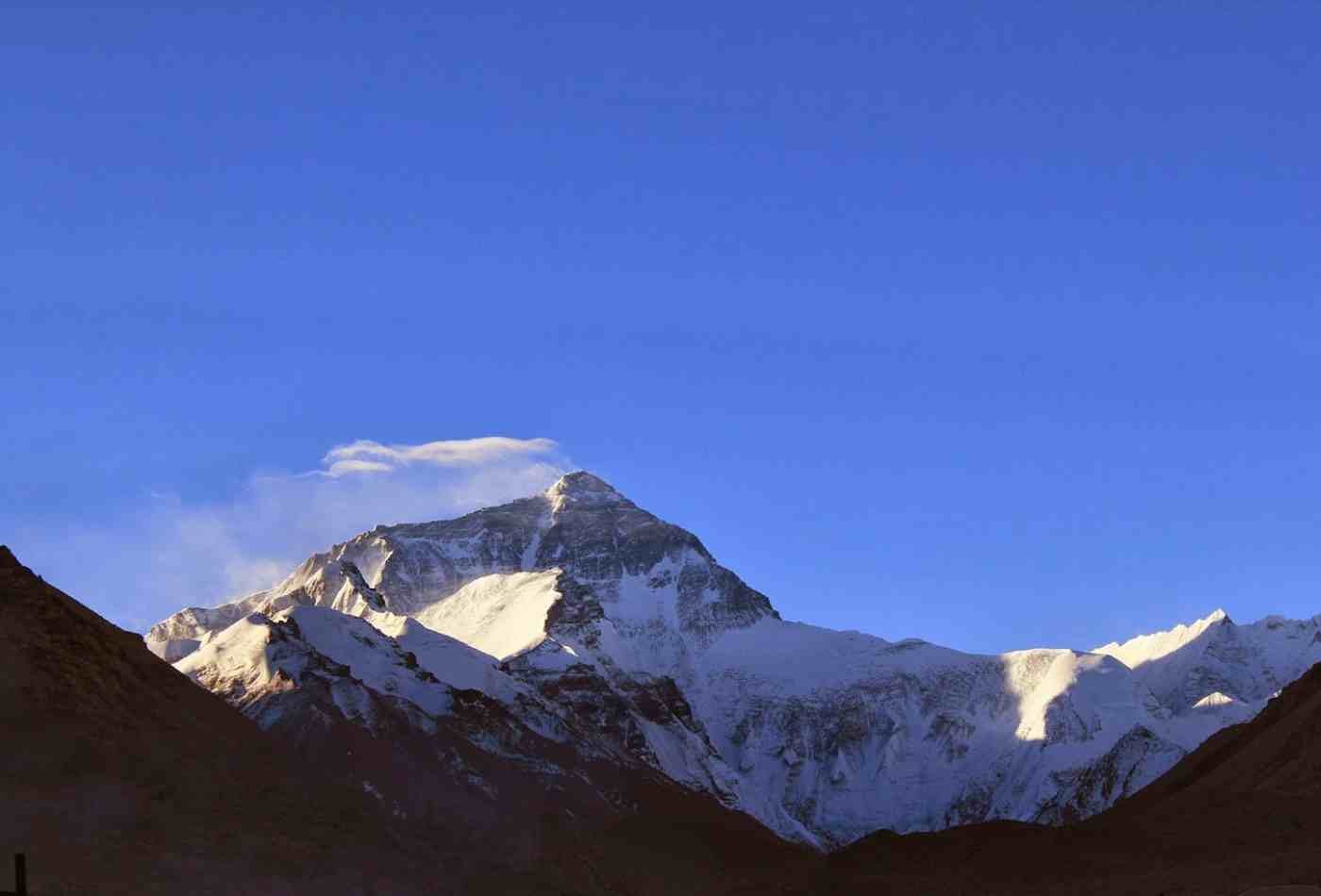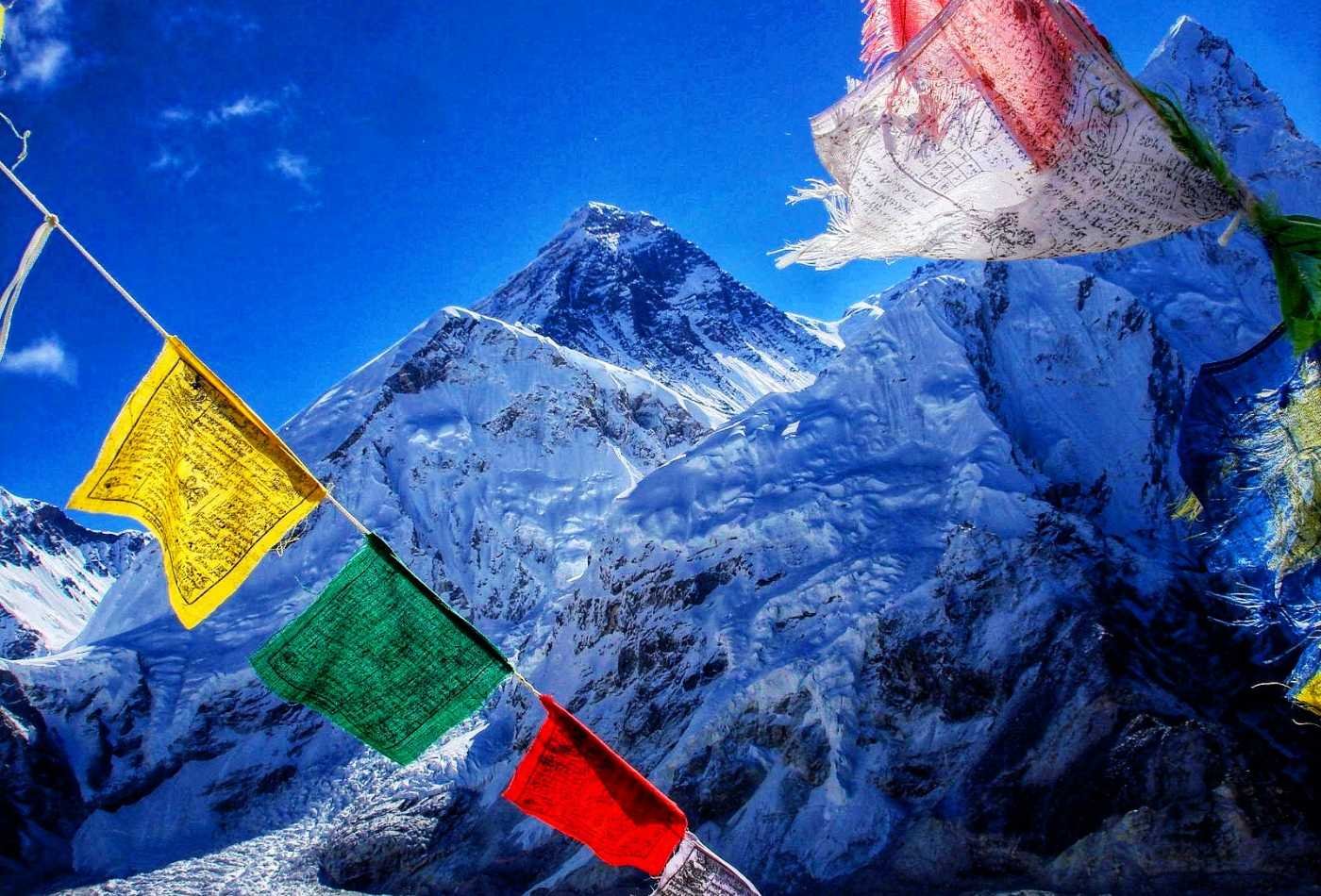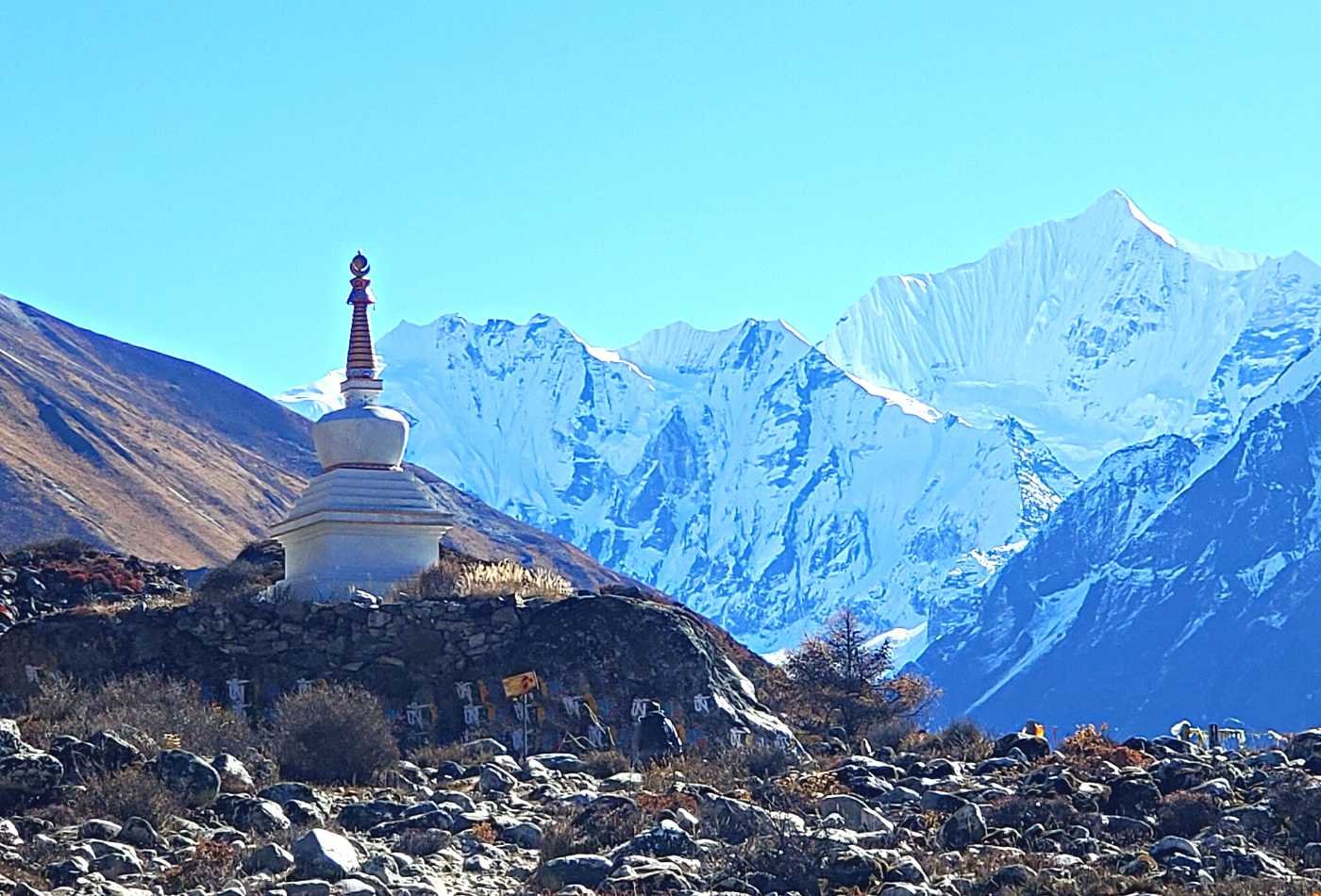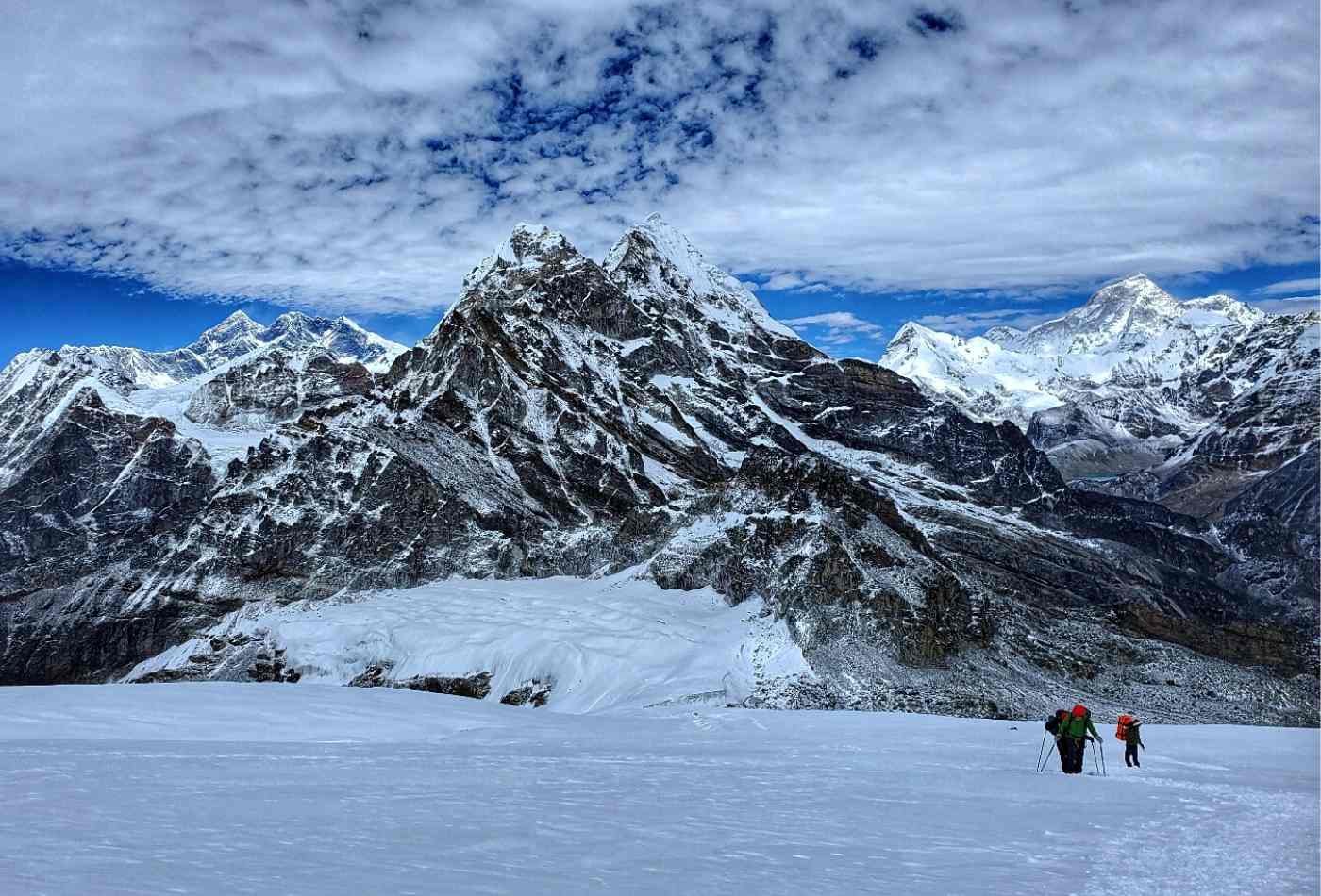
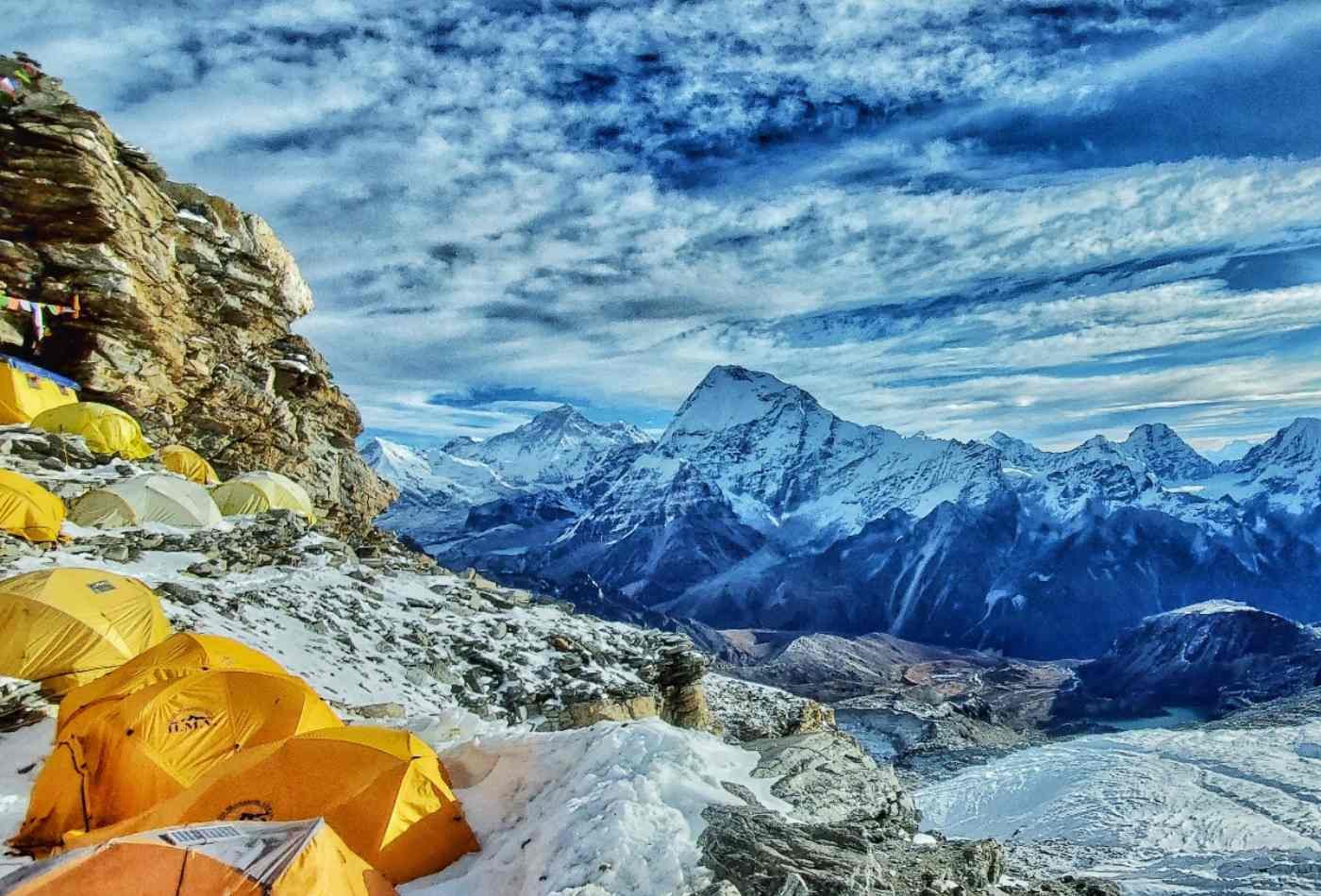
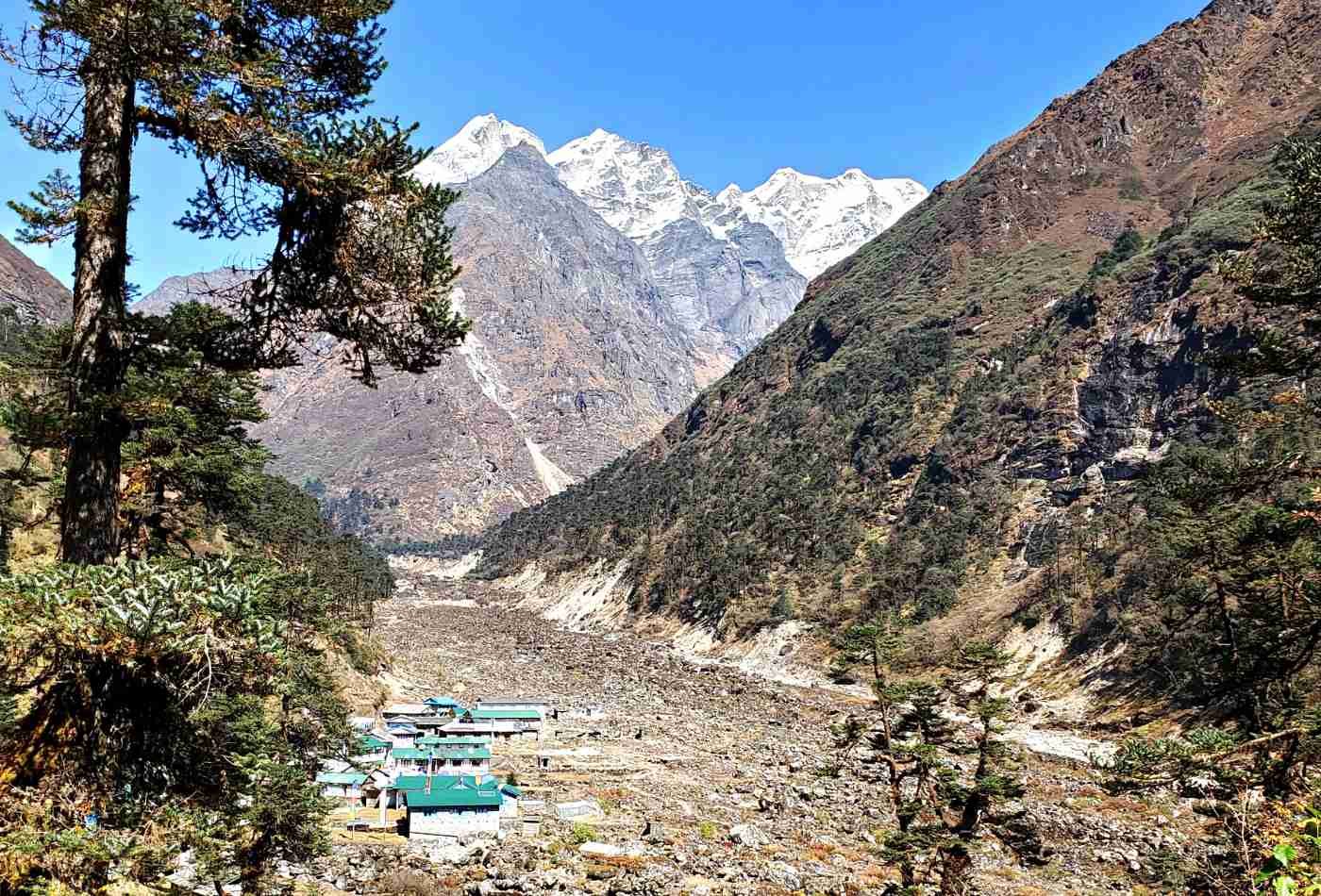
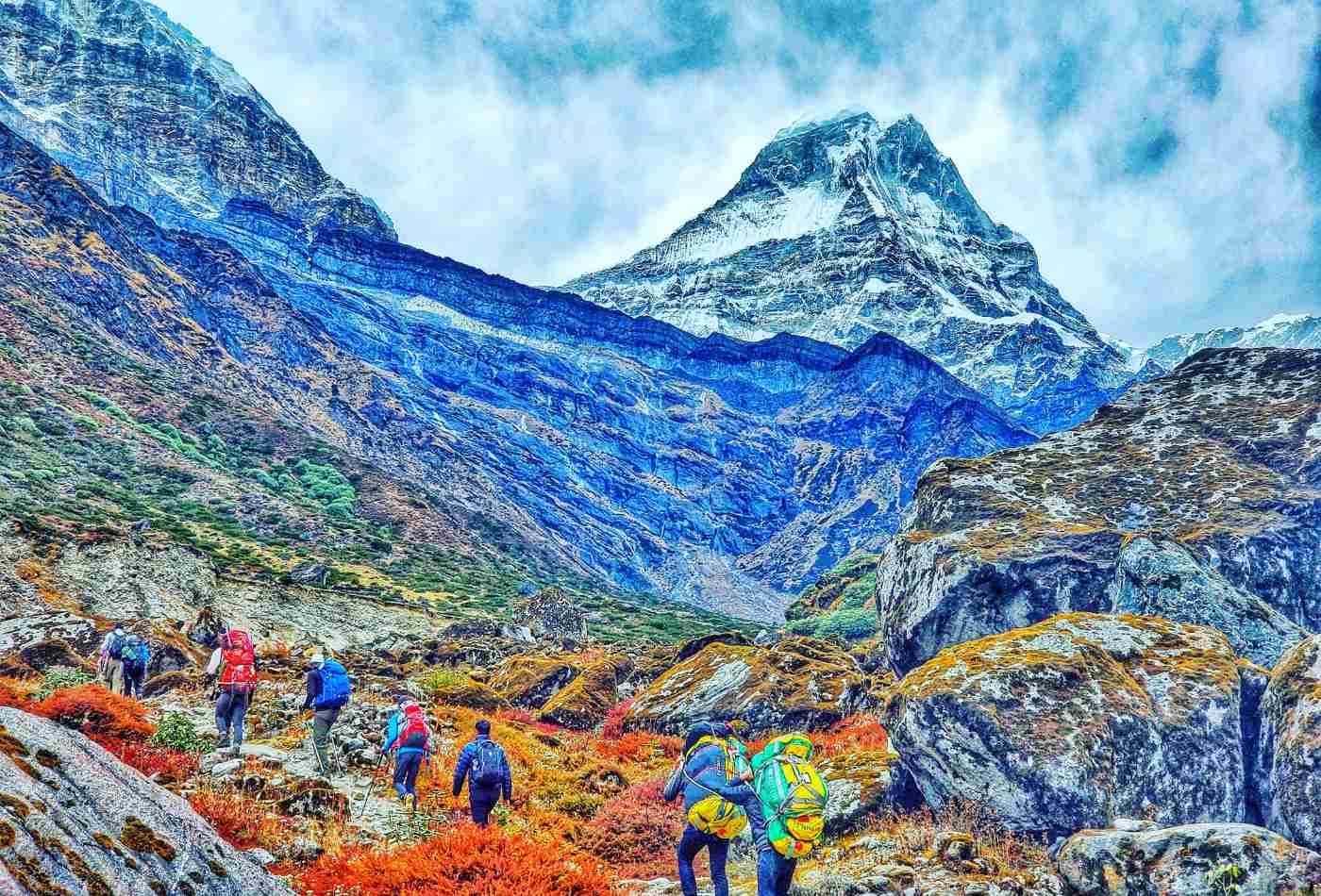

Mera Peak Climbing and Trekking.
TRIP HIGHLIGHTS
- Tour Kathmandu and Climb the famous peak in the Himalayas.
- Tour Buddhist Monasteries and Hindu Temples.
- Visit ancient cities and meet locals in villages.
- Flight to Lukla Airport, a Unique and Famous airport in World.
- Trekking in High Himalayas with Local Guide.
- Explore Buddhism and Hinduism in Nepal.
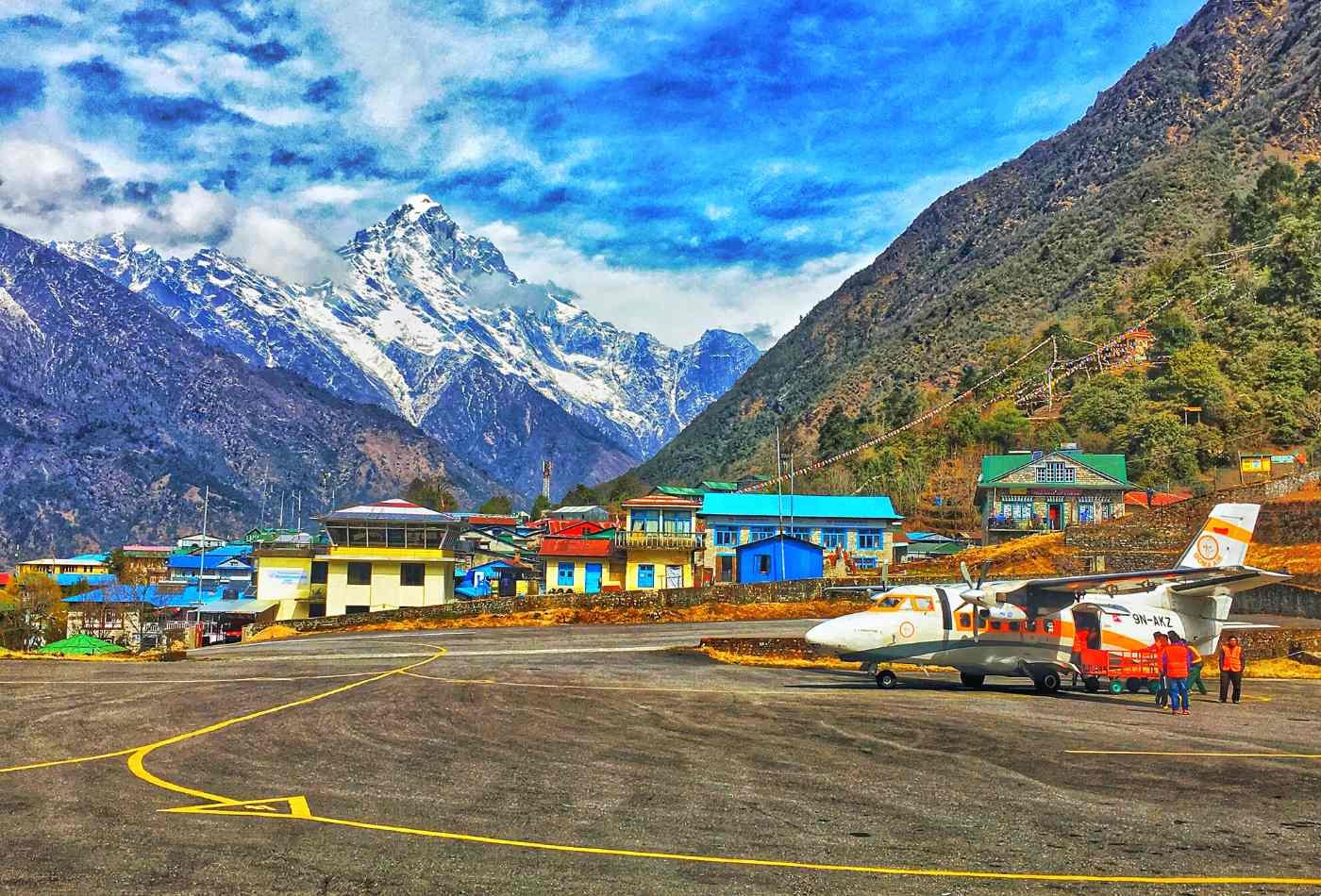
Cost From: $2500 PER PERSON
$350 SINGLE SUPPLEMENT
Return Guests get a 10% discount on all Trips!
-
Trip Type:
Hiking & Climbing
-
Group Size:
1-12 People.
-
Best Time to Visit:
April/May and Sept/Oct
-
Max Altitude:
6,476 meters.
(21,247 ft.)
-
Start-End:
Kathmandu - Kathmandu.
-
Daily Activity:
Tour, Hiking & Climbing.
Location:
Kathmandu Valley (Nepal) and Tibet Autonomous Region.
- Fly into Tribhuvan International Airport (KTM)
DESCRIPTION
Mera Peak (6476m/21,246ft) is a stunning viewpoint for the world's five highest peaks, including Mt. Cho-Oyu in the west and Mt. Kangchenjunga in the east. Mera Peak is the most elevated trekking peak in Nepal and a suitable challenge for a first-time climber and those who plan to climb 8ooo meters mountain in the Himalayas. This peak is situated on the border of Sagarmatha National Park in the West and Arun Valley in the east. The trekking part is regarded as more challenging than peak climbing; the climbing involves long inclined slope walks. Mera Peak can approach through multiple routes; popular among tourists is start and-end trekking in Lukla and taking a flight back to Kathmandu.
Another way to Mera peak is by starting from Jiri or Phaplu, which takes a comparatively extended time. This trekking trail is recognized for its tremendous diversity of plants, animals, and people; the area contains 25 species of rhododendron, 47 types of orchids, and 56 rare plants. Snow leopards, red pandas, musk deer, wild boar, and other wildlife are found here.
TRIP ITINERARY
DAY- 1: Arrive in Kathmandu.
Schedule your flight as your itinerary, and our trekking member will pick you up and drop in hotel. He will brief the next-day schedule.
Stay overnight in Kathmandu.
DAY- 2: Kathmandu Heritage tour and sightseeing.
As per the plan, our guide will pick up for city sightseeing. Three primary Kathmandu heritage
sites, Baudhanath, Pashupatinath, and Kathmandu Durbar-Square, are scheduled for this day.
Stay overnight in Kathmandu.
DAY- 3: Fly to Lukla (2800 m.) and trek to Chhuthang (3050 m.).
DAY- 4: Chhuthang to Tuli Kharka Trek Via Zatrawala Pass (4,600 m.)
After early morning breakfast, we head towards Thuli kharka (4600m). We will cross the Zatrawala pass. This is the first strenuous climb on the Mera Peak route; after a 5-6 hours climb; we will stop overnight at Thli Kharka tea house.
Stay overnight in the Local Tea House.
DAY- 5: Tuli Kharka to Kothe (4182 m./13716 ft.) – 6-7 hours trek.
Trek starts with a gradual descent from Thuki Kharka towards the Hinku River. After the descent, We walked along the river toward the small village of Kothe, located on the bank of the Hinku River.
Stay overnight in the local Tea House.
DAY- 6: Trek Kothe to Thagnak (4356 m.) – 4-5 hours’ trek.
We are now in the Hinku Valley and cross over by way of a yak herders bridge and join the main trail to Mera peak. Today, we gain our first views of dramatic peaks of the valley; Kusum Kanguru to our left, and an unnamed peak over 6700m that stands directly before us. Once we arrive in Thagnak, we see the dramatic south face of Mera peak.
Stay overnight in the Local Tea House.
DAY- 7: Trek to Khare (5000 m.) from Thangnak – 3-4 hours trek.
DAY- 8: Rest for Acclimatization at Khare.
Today is set aside for preparations for the climb and acclimatization. Our climbing guide will provide rehearsal of using harnesses, crampons, axe, traveling roped up, etc. All members will not travel up the mountain and glacier without being briefed and skilled beforehand. Before going sightseeing around and hiking, consult with your guide.
Stay overnight in the Local Tea House.
Day- 9: Khare to High Camp (5700 m.) – 4-5 hours’ Trek.
All is going as planned, and with the weather on our side, we will start our walk to Mera Base Camp. On the way to high camp, you should use your climbing boots and crampons from Mera base camp. Flowing the climber's footsteps and enjoying the mountain's panoramic view, you are now on the north side of Peak, where you can see the summit of Mera peak. High camp is set halfway up the long north slope of the mountain, at about 5700m, near a rock knob. Tonight, you have a sleeping tent on sharing basis. Your guide or driver will escort you to Airport from Hotel. Lhasa Gonggar International Airport is around 65 Km from downtown. Private car or jeep will provide only group departure.
Stay Overnight in the Sleeping Tent.
Day- 10: Summit Mera Peak (6476 m.) and descend to Khare.
The summit approaches will begin early in the morning (anywhere from 2 to 5 am) from this high camp and take around 4 to 6 hours to make the summit. At the same time, the distance doesn’t look far. As the light comes, we can see incredible views across Baruntse (7129m), Chamlang (7319m), and Nau Lekh (6360m), with Makalu (8481m) standing behind. Further to our left is Everest, Cho Oyu, and in the distance on a clear day, Kangchenjunga. Due to the unstable nature of the northern summit knob and time consumption, we will likely ascend Mera's central summit (6461m) once we reach the summit and spend a few minutes on top. We descend back to Khare.
Stay Overnight in The Local Tea House.
Day- 11: A spare Day in case of Bad weather.
Today is a contingency day allowed for inclement weather and poor visibility conditions. We may stop in Khare or High Camp in case of bad weather conditions. Otherwise, we will continue our trip as we planned.
Stay Overnight in the Tea House/Tent.
Day- 12: Khare to Kothe (3700m) – 4-5 hours’ trek.
Feeling tired and exhilarated by our adventure, we pack up and descend the 4-5 hours to the permanent settlement in the valley of Kothe.
Stay overnight in The Local Guest House.
Day- 13: Kothe to Thuli Kharka (4300 m.) – 5-7 hours’ trek.
After an initial hike through the forest and beside the river, the path climbs through a thick forest of birch, rhododendron, and pine. Today is around 5-7 hours’ steady walk, which seems long, but after the summit of Mera, it comparatively seems easy.
Stay Overnight in the Local Tea House.
Day- 14: Descent from Thuli Kharka to Lukla (2800 m).
A short steady climb up to the Zatrwa La pass (approx. 4600m), and then another 30-45 minutes or so onto another Pass which is a little lower and our last before the long descent. The landscape and countryside is spectacular, with expansive views to the south and west, Karyolug and Numbur, and rows and rows of foothills in the southern part.
Stay Overnight in the Local Tea House.
Day- 15: Fly back to Kathmandu.
Early morning short flight from Lukla to Kathmandu, approximately 20-30 mins. Check-in hotel, rest, and shop. Your guide will update you about the following day's schedule.
Stay Overnight in Kathmandu.
Day- 16: An extra day in case of flight cancellation.
Flight from Lukla to Kathmandu is unpredictable due to weather or other circumstances. An alternative route to Kathmandu is via road, which takes at least two days to get to Kathmandu. We recommend scheduling your international flight as per the itinerary to operate your trip smoothly. In case of emergency evacuation from Lukla due to flight cancellation, the minimum cost will be US$350 and the maximum US$700, depending on the number of group members.
Day- 17: Day trip to Bhaktapur.
After breakfast, a guide will pick-up you up from the hotel. Bhaktapur Durbar Square is 13 km east of Katmandu and is listed as a World Heritage site. It’s famous for its art and architecture. Many famous temples and statues are the main attraction of the Bhaktapur Durbar Square.
Stay Overnight in Kathmandu.
Day-18: Final Departure.
Our office staff will drop you at the airport Three hours before the flight schedule.
Notice:
TRIP DETAILS
WHAT'S INCLUDED
✓ Four nights standard hotels in Kathmandu and 14 nights teahouses on sharing basis.
✓ All necessary entry tickets during the tour in Kathmandu sightseeing.
✓ Breakfast-Lunch-Dinner during Trekking.
✓ All listed transport and activities.
✓ Trekking permit, Mera Peak Climbing Permits, and national park tickets.
✓ Arrival and departure transfers.
✓ Experienced Trekking guide and other support staff.
✓Flight ticket KTM – Lukla - KTM.
✓ Proper Insurance of all local staff, including porters.
✓ Service Charge & Government Taxes.
WHAT'S NOT INCLUDED
Personal Travel and Medical Insurances. (Travel insurance is compulsory for all travelers.)
Personal Trekking Gear and Equipment.
Tips and gratitude to the guide and driver.
International flight tickets.
Personal expenses, like laundry, phone calls, snacks & soft drinks.
Lunch and Dinner in Kathmandu during staying in Kathmandu.
Extra cost occurs due to unforeseen circumstances during the trip, like flight cancellation and medical issues.
Visa fees and vaccination. (Covid-19 vaccination is mandatory for all travelers.
WHAT GEAR TO BRING
Once you book this trek you’ll receive access to a printable, downloadable trip information packet with a detailed packing list.
FAQ
How do I sign up for a trip?
Reserving a trip is easy. Send us a note or call us at 734-997-7229 or contact us directly: Pem Dorjee Sherpa at 303-834-5512, info@imperialexpedition.com. Once we have received your information, we will send the trip application. Please complete and return these forms with your deposit of $500 for each person, which amount is applied toward the cost of your trip. Full payment is required if you sign up within 45 days of the trip’s departure. We recommend that you sign up as early as possible. The trip deposit is fully refundable until 90 days before departure, so there is no risk in reserving your space early. All prices quoted are in US dollars and are subject to change. All payments must be made in US dollars. We accept Visa®, MasterCard®, and American Express® as well as personal checks or PayPal. We are also open to creating trips on a first-come-first-serve basis. If there is a trip that you have an interest in particular dates that you have in mind, we will organize a trip just for you.
Once you have paid the deposit, we will finalize your itinerary and send information about health, culture, packing lists, and more to help you get ready. We can also help you find international flights to your destination. Full payment will be due about a month before departure. We will ask for a copy of your passport, a medical form, a release of liability form, an acknowledgment of terms and conditions, a copy of your flights, emergency evacuation insurance, etc. We will be available by phone and email to answer questions and help you organize your trip's details. We will pick you up at the airport and make all local arrangements abroad so that you can get the most out of this once-in-a-lifetime experience.
HOW FIT DO I NEED TO BE TO TREK IN THE HIMALAYAS?
You should be moderately fit, exercise regularly, and enjoy active vacations, walking, and hiking in mountainous terrain. For the Everest base camp trek, you should be able to run for an hour without stopping at any speed and still feel good to continue – OR – walk for 5-6 hours in a day with rests. Trekking is an endurance sport. Mostly you need a good attitude, which will go a long way toward the success of reaching your goal.
When is the Best time to climb Mera Peak?
End of March to till Mid May is the best time to climb Mera peak, whereas October is also popular among climbers; during this season, climbing permits cost $250 Per Person. Spring season is warm and has clear weather compared to other seasons. October and November are also suitable, and climbing permits are only $125 per person, but the weather is cold and may face snowfall.
Do I have a climbing skill to climb Mera Peak?
No, if you are fit for trekking, you can join the climbing team. This peak does not require any technical training to climb. Your guide will brief you on basic instructions before climbing, and you have to follow as guide's instructions.
Do we need special climbing gear to climb Mera Peak?
Yes, You have to spend one night in Highcamp at an altitude of 5700 meters in a sleeping tent set up by your agency, so you must pack warm clothes and a sleeping bag for -20 degree celsius. Besides this equipment, you need crampons, harnesses, and a climbing rope, while approaching the summit, which you can rent in Khare local tea house. We recommend taking your sleeping bag, and climbing shoes fit for you due to the unavailability of your size.
Do we need climbing permits to climb Mera Peak?
Yes, the Nepal Mountaineering association issues your climbing permits, which have to show on the way to Mera Peak. These permits cost $70 to $250 based on the climbing season. These permits are required to get you proof of summit if you want a climbing certificate from Nepal Mountaineering Association.
How big will the group be?
We try to bring together a small group of like-minded people. Our trekking groups generally range from 2 to a maximum of 12 members, although we can accommodate smaller groups. You can go for a solo trip to Mera peak though the cost is higher than joining the group.
What are the biggest challenges of climbing Mera Peak?
Altitude is one of the biggest challenges for climbing Mera Peak. Due to the high altitude, you may suffer from high altitude sickness during the trek in the Mountains. To avoid Altitude Mountain sickness, we acclimatize when trekking. The second challenge is weather conditions; we have to cancel or turn back due to bad weather. Physical illness also may cause problems during the trip, so you must care about your diet and outfit to protect yourself from cold.
WHAT SORT OF EXPERIENCE DO YOUR GUIDES HAVE?
Our guides are dependable, competent, and highly qualified, with more than ten years of trekking experience, leading trips, treks, climbs, and expeditions in the Himalayas. Our guides speak English and the local language. We are trained in first aid and CPR. Most importantly, our guides are friendly and enjoyable and passionate about sharing Nepal's rich cultures, traditions, and natural beauty.
WHAT IS THE ROUTINE ON THE TREK?
Most trekkers start their day early, around 7:30 to 8:30 am, after a hot breakfast. The morning sun offers nice mountain views. You will carry a light pack for your camera, water, a jacket, and a wind layer. Around noon we will reach the lunch stop, where we will spend time drinking tea, resting, and having lunch. After lunch, we usually walk for 2 to 3 more hours before arriving, where we will stop for the evening. Here at the lodge, we will have hot tea and relax for the rest of the day. Our day ends with dinner, and then off to bed in single or double rooms in the trekking lodge.
What if I have to cancel?
If you decide to cancel your trip, the following fees apply and are due to Imperial Expedition prior to departure when we receive written notice of your cancellation. Cancellation Fee Schedule for tours and treks:
- 90-81 days prior to departure You forfeit half the deposit
- 80-60 days prior to departure You forfeit the deposit
- 59-31 days prior to departure You forfeit 50% of the total amount
- 30 or fewer days prior to departure You forfeit the entire cost of the trip
Cancellation Fee Schedule for Climbing Trips and Expeditions:
- 180-150 days prior to departure You forfeit
- 149-89 days prior to departure You forfeit 50% of the total amount
- 90 or fewer days prior to departure You forfeit the entire cost of the trip
HOW LONG DO WE WALK EACH DAY?
Our trips are classified into three categories according to the level of difficulty. Easy adventure treks are about a week to 10 days in duration. They generally don’t go above 13,000 feet (4,000m). You can expect hiking/walking for around 4-5 hours daily. Moderate to somewhat challenging treks are longer treks that go into a high mountain country above 13,000 feet (4,000m). Physically these trips are more demanding and tiring and may involve 6-8 hours of trekking along rocky trails in high Himalayan terrain. Strenuous treks are longer treks that go beyond the everyday activities of trekkers and tourists. These include ice climbing and mountaineering expeditions. Physically challenging, these trips may involve 7-9 hours of trekking in a day and are likely to include unfavorable weather conditions and strenuous activities. Some level of experience may be required for these trips.
Can we access the internet and use our cell phones during Trek?
Yes, you can activate your international roaming service before entering Nepal, which costs more expensive than your regular service at home. You can use WIFI in the Local Tea House, where you have to charge $2 to $5 to use WIFI, or you can buy a recharge card to use internet data. Specific locations may be out of connection by cell phone service and WIFI where we can use the satellite phone.
What happens in case of an emergency?
In the case of a serious illness or a life-threatening emergency during your trek, a helicopter rescue will be initiated. You are responsible for all the expenses incurred in such an evacuation. It is required that you have insurance that covers emergency helicopter evacuation throughout your trip. However unlikely, we are prepared for emergencies, and your guide will respond quickly to get any necessary medical help. We aim to avoid such circumstances with education and a large dose of preventative medicine.
Can I get a Nepal visa on arrival?
Custom Declaration on Kathmandu, Nepal Arrival (For Foreign Nationals)
1. Travelers must declare goods over permitted personal effects and duty-exempted consumable goods and restricted/prohibited goods and commercial goods at the red channel. Travelers possessing such goods may use the green channel.
2. Export or import narcotics, arms and explosives, wildlife and its products, and commercial goods are restricted/prohibited. Attempt to import or export such goods may lead to confiscation of goods, penalty, and arrest resulting in prosecution.
3. Travelers must declare foreign currency at the red channel if the sum exceeds US$2000 or equivalent.
4. Permitted used personal effects are as follows in condition to return at the time of departure:
1. Binocular one set.
2. Video Camera and still camera one set each.
3. Portable music system one set recorded media 10 pcs.
4. Cloths and goods of day-to-day use.
5. Perambulator and tricycle, one set each.
6. Bicycle one set.
7. Watch one piece.
8. Cellular mobile phone one set
9. Professional hand tools are one set for professional personnel.
5. Duty-exempted consumable goods are as follows:
1. Whiskey/wine not exceeding 1.15 liters or beer up to 12 cans.
2. Cigarettes 200 sticks, cigar 50 sticks, tobacco 250 grams.
3. Camera film up to 15 pcs and movie film 12 reels.
4. Readymade and can foods not exceeding NRs.1000.00.
5. Medicine not exceeding Nrs.1000.00.
6. Fresh fruits not exceeding NRs.1000.00
Is it possible to deviate from the itinerary?
Our specific itineraries are custom crafted with you in mind. Once we agree on a plan, we can make minor changes and adjustments en route. The itinerary acts as a general plan for the trip. However, there are often local events, festivals, and holidays that could affect or change our schedule. As long as everyone agrees on these changes, that is fine. Significant changes to the itinerary may be made if there are political or environmental concerns. Your guide will be able to help to make any necessary adjustments. Our trips are adventures that may take you into remote regions where unforeseen circumstances may contribute to the need for a change in the itinerary.
Do you have any suggestions on what to do and what not to do concerning the Nepalese culture?
-
The most common greeting in Nepal is “Namaste,” performed by placing the palms together and bowing as if praying.
-
Before entering a Nepalese home, temple or monastery, remember to remove your shoes and place them neatly side-by-side.
-
Be careful not to use your spoon, fork, or hands to touch another person’s food, plate, cooking utensils, or even the serving dish. Do not eat from other people’s plates, and do not drink from other people’s water bottles or glasses. This is considered to be impure by the Nepalese.
-
Never touch anything with your feet. The feet and the floor are considered dirty.
-
While traveling, please feel free to dress appropriately. Women should avoid short skirts and sleeveless shirts.
-
Seek permission before entering a Hindu temple. Many Hindu temples do not allow non-Hindus to enter.
-
Leather is prohibited inside temples because cows are considered sacred and are not used for slaughter.
-
Walking around temples or Buddhist stupas is traditionally done clockwise.
-
Ask before taking photographs of the locals. Some believe part of the soul is taken when a picture is snapped.
-
Public displays of affection between a man and a woman are frowned upon and are not generally accepted.
-
When the Nepalese shake their head from left to right, they may mean, “Yes.”
-
Develop a genuine interest in Nepal and meet and talk to the Nepalese people. Do your best to respect their local customs and traditions.
Payment methods.
What about transferring trips?
Tours and trekking trips may be transferred to the next year or another date; however, the transfer must be made 90 days or more before departure. Otherwise, if the transfer is made 90 days or less before departure, you must pay the cancellation fees outlined above. There are no extra fees for transferring trips more than 90 days before departure. However, for climbing trips and expeditions, if you would like to change our trip to the next year or different dates, an automatic transfer fee of $1,000 must be paid to Imperial Expedition.
Should I purchase trip cancellation insurance?
Suppose you must cancel your trip due to illness, injury, or death of yourself or an immediate family member, trip cancellation insurance protects all your deposits and payments for air and land costs. It is recommended that you buy trip cancellation insurance, but optional.
What if Of Imperial Expedition cancels my trip?
Imperial Expedition reserves the right to cancel all or a portion of a trip due to political or environmental circumstances which may hinder trip operations or for other reasons beyond our control. In case of such a cancellation, we will give a full refund for the cost of the trip. However, Imperial Expedition is not responsible for additional expenses incurred by you in preparing for the trip, visa fees, gear, insurance, or medical expenses prior to the trip. The airline's refund policy applies if international air tickets have been purchased.
What other expenses should I consider?
Medical advice and inoculations, health and travel insurance, travel and trekking gear, international airfare, Nepali visas, airport tax, spending money, and most meals are not included in the cost of your trip.
How much should I budget for tipping?
Your support team will work hard to please you during your trip. They will appreciate receiving a tip at the end of their service. The amount you give depends on you and your appreciation of their work. We recommend giving tips from $200 – $300 to your porters.
Electricity in Nepal
Residential electrical outlets in some countries, including the United States, use 110-120 volts of electricity and accept certain plugs. Many other countries, including Nepal, use 220-240 volts to power their appliances and different plugs. If you try to plug an American device, such as a shaver or hair dryer, into an outlet of a different voltage, you may destroy the appliance and cause yourself injury. Before you travel, you should know a few things about other countries (like Nepal).
Contact Us
Related Trips
